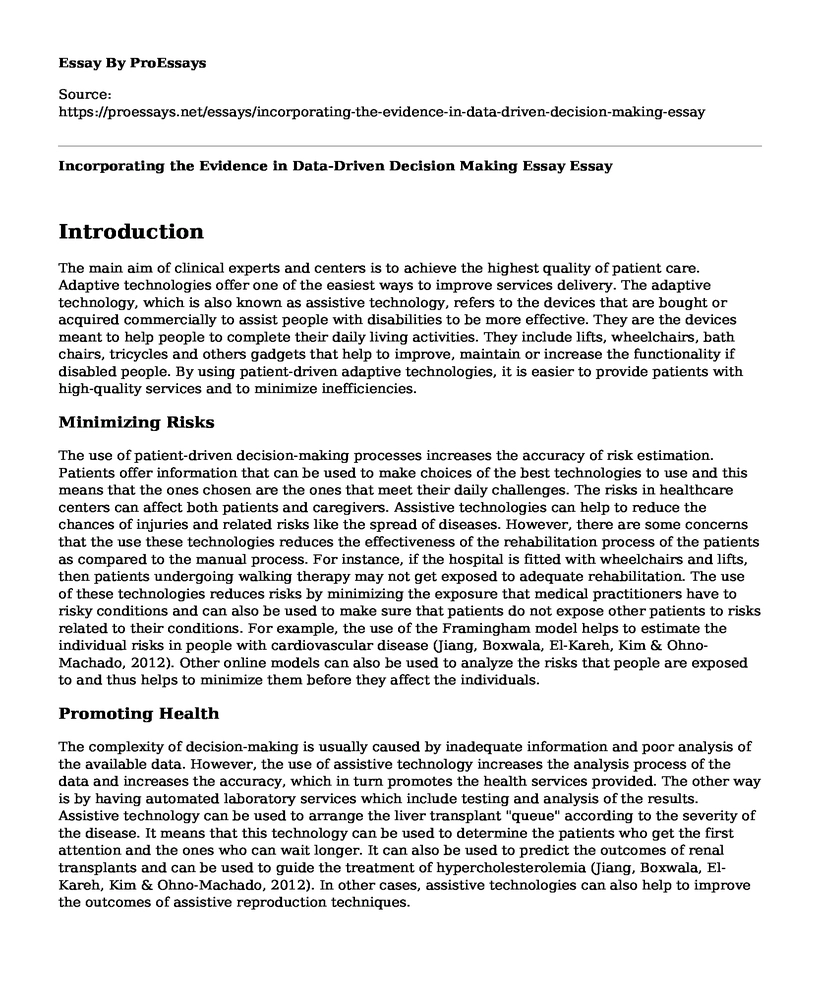Introduction
The main aim of clinical experts and centers is to achieve the highest quality of patient care. Adaptive technologies offer one of the easiest ways to improve services delivery. The adaptive technology, which is also known as assistive technology, refers to the devices that are bought or acquired commercially to assist people with disabilities to be more effective. They are the devices meant to help people to complete their daily living activities. They include lifts, wheelchairs, bath chairs, tricycles and others gadgets that help to improve, maintain or increase the functionality if disabled people. By using patient-driven adaptive technologies, it is easier to provide patients with high-quality services and to minimize inefficiencies.
Minimizing Risks
The use of patient-driven decision-making processes increases the accuracy of risk estimation. Patients offer information that can be used to make choices of the best technologies to use and this means that the ones chosen are the ones that meet their daily challenges. The risks in healthcare centers can affect both patients and caregivers. Assistive technologies can help to reduce the chances of injuries and related risks like the spread of diseases. However, there are some concerns that the use these technologies reduces the effectiveness of the rehabilitation process of the patients as compared to the manual process. For instance, if the hospital is fitted with wheelchairs and lifts, then patients undergoing walking therapy may not get exposed to adequate rehabilitation. The use of these technologies reduces risks by minimizing the exposure that medical practitioners have to risky conditions and can also be used to make sure that patients do not expose other patients to risks related to their conditions. For example, the use of the Framingham model helps to estimate the individual risks in people with cardiovascular disease (Jiang, Boxwala, El-Kareh, Kim & Ohno-Machado, 2012). Other online models can also be used to analyze the risks that people are exposed to and thus helps to minimize them before they affect the individuals.
Promoting Health
The complexity of decision-making is usually caused by inadequate information and poor analysis of the available data. However, the use of assistive technology increases the analysis process of the data and increases the accuracy, which in turn promotes the health services provided. The other way is by having automated laboratory services which include testing and analysis of the results. Assistive technology can be used to arrange the liver transplant "queue" according to the severity of the disease. It means that this technology can be used to determine the patients who get the first attention and the ones who can wait longer. It can also be used to predict the outcomes of renal transplants and can be used to guide the treatment of hypercholesterolemia (Jiang, Boxwala, El-Kareh, Kim & Ohno-Machado, 2012). In other cases, assistive technologies can also help to improve the outcomes of assistive reproduction techniques.
Encouraging Patients Engagement
The use of assistive technology improves the ability of patients to get engaged in the treatment process. For example, improved communication in healthcare increases the efficiency of the process. Better intervention and appraisal processes can be achieved by the use of assistive technology and this increases the engagement of the patients in the treatment process (Wu et al., 2012). The use of technology reduces the complexity of the treatment process and makes it possible for patients to contribute their ideas and the improved communication make it easy for them to understand their conditions and how they can improve the effectiveness of the treatment process.
References
Jiang, X., Boxwala, A. A., El-Kareh, R., Kim, J., & Ohno-Machado, L. (2012). A patient-driven adaptive prediction technique to improve personalized risk estimation for clinical decision support. Journal of the American Medical Informatics Association, 19(e1), e137-e144.
Wu, R. C., Tran, K., Lo, V., O'Leary, K. J., Morra, D., Quan, S. D., & Perrier, L. (2012). Effects of clinical communication interventions in hospitals: a systematic review of information and communication technology adoptions for improved communication between clinicians. International journal of medical informatics, 81(11), 723-732.
Cite this page
Incorporating the Evidence in Data-Driven Decision Making Essay. (2022, Sep 22). Retrieved from https://proessays.net/essays/incorporating-the-evidence-in-data-driven-decision-making-essay
If you are the original author of this essay and no longer wish to have it published on the ProEssays website, please click below to request its removal:
- Essay on Healthcare Committee Structure
- Research Proposal Example: Impact of Medical Procedure Prices on Society
- Diagnosis Effects of Chemotherapy for Breast Cancer
- Children Vaccination Essay
- Research Paper on Nalfon Drug
- Essay Example on Brain Drain: Challenges in Healthcare Delivery in Underdeveloped Nations
- Miss Maria: A Social Worker Interview Revealing the Roles of Direct and Clinical Workers - Essay Sample







